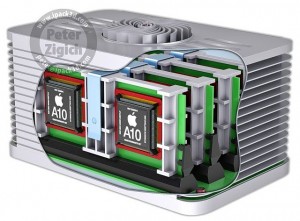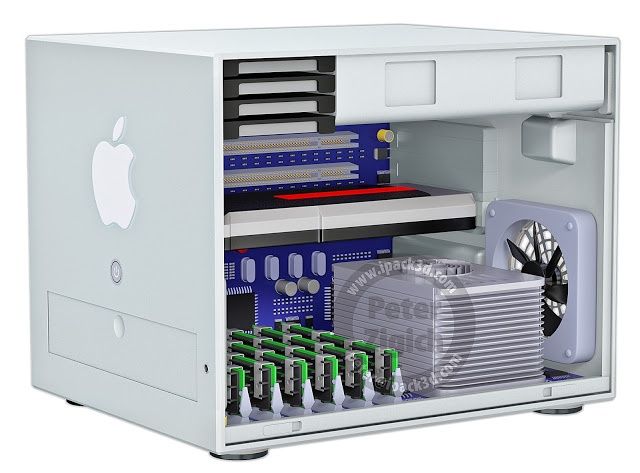Apple hasn’t updated the Mac Pro significantly since 2010, much to the dismay of professional Mac users. That’s why there’s keen interest in the future Mac Pro: Apple has reiterated its committment to the beefy desktop powerhouse, yet it’s the only Mac to not undergo a major redesign in the last couple of years. Eager eyes look to the future of the Mac Pro line to see what’s next.
A new series of concept images by Peter Zigich have been doing the rounds today, and they are getting a lot of buzz. The images describe a Mac Pro that isn’t just significantly smaller and more power efficient than the existing Mac Pro, but that eschews Intel’s server-class CPUs in favor of custom-built A-series chips.
Darrell Etherington over at Techcrunch says that while “obviously a flight of pure fancy, ” Zigich’s concept is “one that takes serious the question of what comes next for the standalone desktop PC in a mobile-first world.”
It does nothing of the sort. Zigich’s concept isn’t just a flight of fancy, it’s nonsense. Here’s why.
Let’s start with an important question: what kind of customer is the Mac Pro aimed at?
The answer’s right in the name. It’s for pros: digital professionals who need a Mac that isn’t just expandable, but that is the most powerful Mac of any class, so that they can run resource-intensive apps like Adobe PhotoShop, AfterEffects, Final Cut Pro and more.
Right away, then, we have a problem with an ARM-based Mac Pro. None of these apps run on ARM processors. Even if ARM chips were as powerful as Intel-based chips — and they aren’t — a Mac Pro based upon ARM wouldn’t be able to run apps made for OS X. In other words, the very apps that professionals purchase Mac Pros to run quickly wouldn’t function at all if Apple switched processors to ARM.
The very apps that professionals purchase Mac Pros to run wouldn’t function at all if Apple switched processors to ARM.
What about some sort of emulation layer that allows apps built for Intel processors to run on ARM? Apple’s done that before, of course, when they moved from Power PC to Intel processors. They wrote an emulation layer called Rosetta that automatically translated programs written for the Power PC to work on an x86 processor instead.
The problem is that to emulate one platform, you need to do it on a more powerful platform. When Apple shifted from Power PC chips to Intel chips, they switched to chips that were actually much faster and more powerful than they’d been previously using. Even so, Intel-based Macs ran apps built for the Power PC slower than those same apps had usually run on older Macs. For emulation to work on an ARM-based Mac, then, Apple would need to make an ARM chip that was more significantly more powerful than the Intel processors currently being used in the Mac Pro.

For his concept, Zigich imagines an A10 processor that would meet that performance metric. Zigich sees the A10 chip as being capable of being daisy-chained together, up to 12 CPUs in a row, yet it’s hard to imagine how even in that configuration, an ARM-based Mac Pro would be more powerful than a current Intel-based one. After all, the A6-series chip inside your iPhone is about as powerful as a ten-year old chip from Intel, and it’s not even clear if an ARM chip that was as powerful as Intel’s would actually see a negligible advantage in power usage.
RIM’s biggest advantages over Intel are in power-management, not in sheer performance, and even there, Intel is catching up. Why would Apple sacrifice the one metric that sells Mac Pros — raw power — for a metric that professionals don’t really care about, power-management, that Intel’s addressing anyway?
So here’s the question. Would Apple make a new Mac Pro that ran on ARM? For you to believe that this idea has merit, you need to believe that the kinds of consumers who buy Mac Pros would gladly buy a machine on which none of their existing apps worked, just to save a couple bucks a month on their power bills. This is the same class of customer, mind you, that utterly freaked the cow when Apple significantly re-imagined Final Cut Pro X and had their existing workflows all messed up. Do you really think these guys are going to buy new ARM-based Mac Pros when it means changing every single aspect of how they do their jobs?
The thing that separates Apple from the competition is they are eager to embrace the future and quick to abandon the cruft of the past. Yet when Apple moves on, it’s always to something better for consumers. Sure, consumers sometimes don’t know what’s best for them, like abandoning optical drives in Macs, but Apple doesn’t outright betray them.
An ARM-based Mac Pro would be like an iPhone powered by Android. Ugh.
The only way an ARM-based Mac Pro would be better than an Intel-based one is in a way that its core audience — professionals — don’t care about. An ARM-based Mac Pro would be like an iPhone powered by Android: an interesting exercise, but one that would completely honk off the customers who care about it the most. Ugh.


